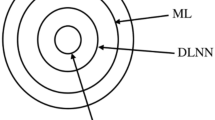Abstract
Traditional control methods of two-wheeled robot are usually model-based and require the robot’s precise mathematic model which is hard to get. A sensorimotor self-learning model named SMM TWR is presented in this paper to handle these problems. The model consists of seven elements: the discrete learning time set, the sensory state set, the motion set, the sensorimotor mapping, the state orientation unit, the learning mechanism and the model’s entropy. The learning mechanism for SMM TWR is designed based on the theory of operant conditioning (OC), and it adjusts the sensorimotor mapping at every learning step. This helps the robot to choose motions. The leaning direction of the mechanism is decided by the state orientation unit. Simulation results show that with the sensorimotor model designed, the robot is endowed the abilities of self-learning and self-organizing, and it can learn the skills to keep itself balance through interacting with the environment.
Similar content being viewed by others
References
CHAN R P M, STOL K A, HALKYARD C R. Review of modelling and control of two-wheeled robots [J]. Annual Reviews in Control, 2013, 37: 89–103.
SUPRAPTO B Y, AMRI D, DWIJAYANTI S. Comparison of control methods PD, PI, and PID on two wheeled self balancing robot [C]//Proceeding of International Conference on Electrical Engineering, Computer Science and Informatics. Yogyakarta, Indonesia: IEEE, 2014: 67–71.
BATURE A A, BUYAMIN S, AHMAD M N, et al. A comparison of controllers for balancing two wheeled inverted pendulum robot [J]. International Journal of Mechanical & Mechatronics Engineering, 2014, 14(3): 62–68.
ALARFAJ M, KANTOR G. Centrifugal force compensation of a two-wheeled balancing robot [C]//Proceeding of International Conference on Control, Automation, Robotics and Vision. Singapore: IEEE, 2010: 2333–2338.
ZHOU Y S, WANG Z H. Motion controller design of wheeled inverted pendulum with an input delay via optimal control theory[J]. Journal of Optimization Theory and Application, 2016, 168(2): 625–645.
LI C Q, GAO X S, HUANG Q, et al. A coaxial couple wheeled robot with T-S fuzzy equilibrium control [J]. Industrial Robot: An International Journal, 2011, 38(3): 292–300.
NASIR A N K, AHMAD M A, GHAZALI R, et al. Performance comparison between fuzzy logic controller (FLC) and PID controller for a highly nonlinear twowheels balancing robot [C]//2011 First International Conference on Informatics and Computational Intelligence. Bandung, Indonesia: IEEE, 2011: 176–181.
YUE M, WANG S, SUN J Z. Simultaneous balancing and trajectory tracking control for two-wheeled inverted pendulum vehicles: A composite control approach [J]. Neurocomputing, 2016, 191: 44–54.
RUAN X G, WU X. The skinner automaton: A psychological model formalizing the theory of operant conditioning [J]. Science China Technological Sciences, 2013, 56(11): 2745–2761.
RUAN X G, CHEN J, YU N G. Thalamic cooperation between the cerebellum and basal ganglia with a new tropism-based action-dependent heuristic dynamic programming method [J]. Neurocomputing, 2012, 93: 27–40.
SKINNER B F. The behavior of organisms: An experimental analysis [M]. New York: D Appleton-Century Company, 1938.
ROSEN B E, GOODWIN J M, VIDAL J J. Machine operant conditioning [C]//Annual International Conference of the IEEE Engineering in Medicine and Biology Society. Piscataway, USA: IEEE, 1988: 1500–1501.
ZALAMA E, GóMEZ J, PAUL M, et al. Adaptive behavior navigation of a mobile robot [J]. IEEE Transactions on Systems, Man, and Cybernetics. Part A: Systems and Humans, 2002, 32(1): 160–169.
ITOH K, MIWA H, MATSUMOTO M, et al. Behavior model of humanoid robots based on operant conditioning [C]//Proceedings of 2005 5th IEEE-RAS International Conference on Humanoid Robots. Tsukuba: IEEE, 2005: 220–225.
TANIGUGHI T, SAWARAGI T. Incremental acquisition of behaviors and signs based on a reinforcement learning schemata model and a spike timingdependent plasticity network [J]. Advanced Robotics, 2007, 21(10): 1177–1199.
CHEU E Y, QUEK C, NG S K. ARPOP: An appetitive reward-based pseudo-outer-product neural fuzzy inference system inspired from the operant conditioning of feeding behavior in aplysia [J]. IEEE Transactions on Neural Networks and Learning Systems, 2012, 23(2): 317–329.
PIAGET J. The origins of intelligence in children [M]. New York: International Universities Press, 1952.
LEE D D, SEUNG H S. Learning in intelligent embedded systems [C]//Proceedings of the Embedded Systems Workshop. Cambridge, USA: IEEE, 1999: 133–139.
NATALE L, ORABONA F, BERTON F, et al. From sensorimotor development to object perception [C]//Proceedings of 2005 5th IEEE-RAS International Conference on Humanoid Robots. Tsukuba: IEEE, 2005: 226–231.
HOFFMANN H. Perception through visual motor anticipation in a mobile robot [J]. Neural Networks, 2007, 20(1): 22–33.
REN H G, SHI T, ZHANG R C. Foundation of the sensorimotor system cognitive model with operant conditioning mechanism [J]. Robot, 2012, 34(3): 292–298 (in Chinese).
Acknowledgments
Part of this research was done at the Department of Psychology, Michigan State University. The authors would like to express their thanks to Professor LIU Taosheng and his lab for help.
Author information
Authors and Affiliations
Corresponding author
Additional information
Foundation item: the National Natural Science Foundation of China (No. 61375086), the Key Project of Science and Technique Plan of Beijing Municipal Commission of Education (No. KZ201210005001), the National Basic Research Program (973) of China (No. 2012CB720000), and the China Scholarship Council Program (No. 201406540017)
Rights and permissions
About this article
Cite this article
Zhang, X., Ruan, X., Xiao, Y. et al. Sensorimotor self-learning model based on operant conditioning for two-wheeled robot. J. Shanghai Jiaotong Univ. (Sci.) 22, 148–155 (2017). https://doi.org/10.1007/s12204-017-1814-8
Received:
Published:
Issue Date:
DOI: https://doi.org/10.1007/s12204-017-1814-8




